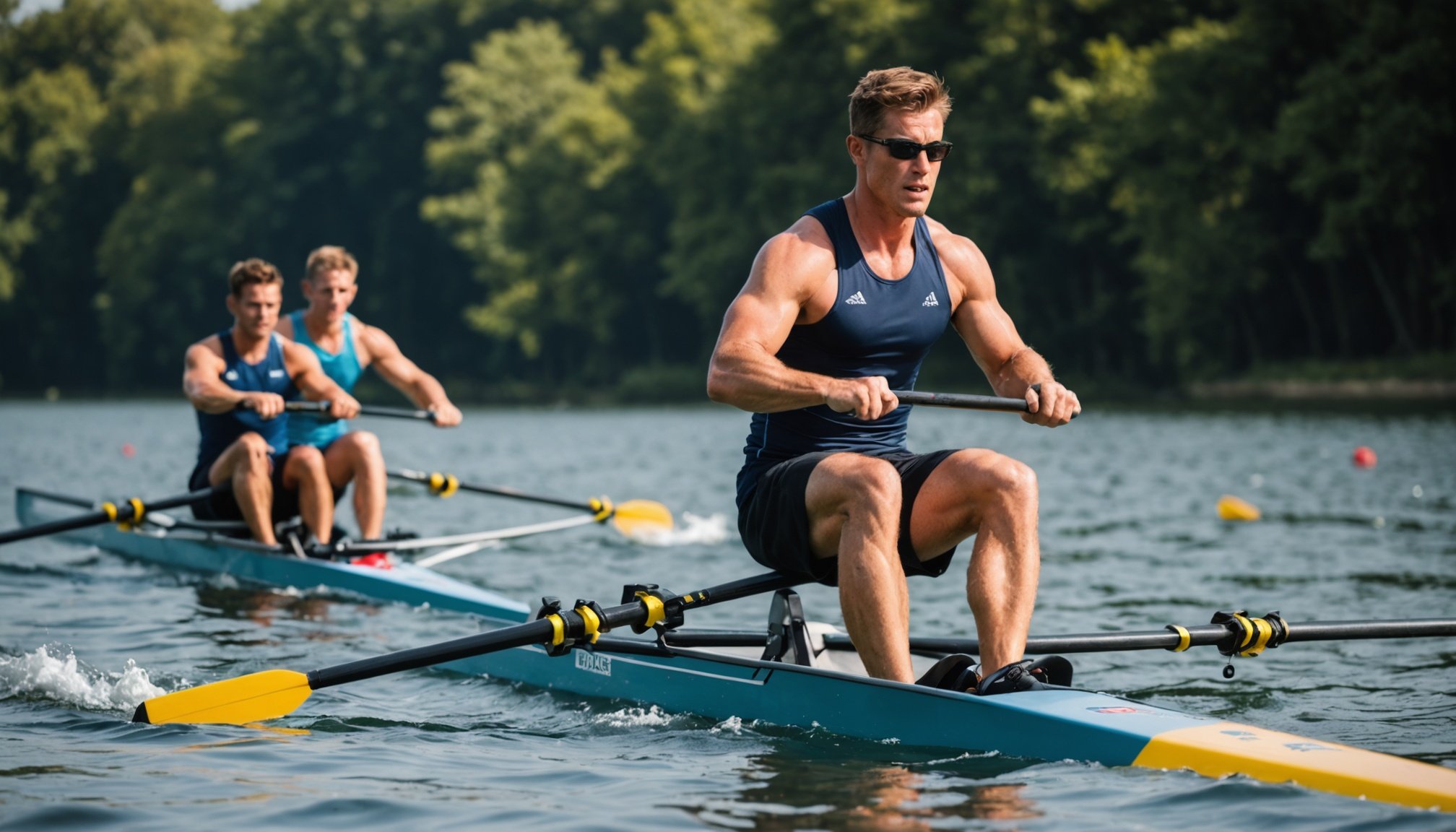Understanding Aerobic Performance in Rowing
Rowing is a sport where aerobic performance plays a crucial role, enabling athletes to sustain effort over prolonged periods. This endurance-based discipline demands significant energy, with aerobic capacity being a defining factor in successful rowers.
Enhanced rowing efficiency is achieved through specific physiological adaptations. These include increased lung capacity, heightened oxygen uptake, and improved muscular endurance. Such developments are facilitated through endurance training aimed at strengthening the cardiovascular system and augmenting muscle endurance.
Also read : Mastering olympic glory: innovative precision training strategies for top-level shooters
Several factors influence an athlete’s aerobic capacity. Genetics, training volume, intensity, and consistency of workouts contribute significantly. Additionally, nutrition, recovery techniques, and psychological resilience play pivotal roles in optimising performance. Adapting individualized training regimens can further leverage these components to enhance aerobic capacity.
Rowers strive for a balance between power and endurance, benefiting greatly from targeted endurance training. The incorporation of interval workouts coupled with sustained efforts during training sessions is an effective strategy to boost anaerobic threshold and aerobic capacity. By focusing on the development of these key adaptations, rowers can achieve remarkable efficiency and sustainability in their performance, ensuring they excel both in competition and training scenarios.
In parallel : Unleashing mental fortitude: proven psychological techniques to overcome the pressures of global competitions
Overview of High-Intensity Interval Training (HIIT)
High-Intensity Interval Training (HIIT) is a form of exercise characterised by brief, intense bursts of activity followed by short recovery periods. Workout structure in HIIT is crucial, ensuring workouts are both effective and sustainable. Compared to traditional endurance training, HIIT maximises physiological benefits in a shorter timeframe, making it appealing to athletes aiming to enhance aerobic conditioning.
HIIT differs fundamentally from traditional endurance workouts by focusing on efficiency. Unlike lengthy endurance sessions, HIIT compresses vigorous activity into a compact period, which enables athletes to achieve significant aerobic gains even when time-constrained. This is achieved through a workout structure that alternates between intense anaerobic activity and low-intensity recovery periods.
Among the main physiological benefits of HIIT are improved cardiovascular health, increased VO2 max, and enhanced metabolic rate. These adaptations are particularly relevant for athletes, as they provide a robust foundation for boosting overall performance. The intense nature of HIIT stimulates both aerobic and anaerobic systems, making it an efficient workout choice.
For rowers, integrating HIIT into their routines can lead to notable improvements in aerobic performance, supporting their need for sustained energy and endurance during races.
Scientific Studies on HIIT for Rowers
High-Intensity Interval Training (HIIT) has been extensively explored in the context of rowing, with numerous HIIT research studies examining its impact on performance outcomes. Key training studies reveal that HIIT can significantly enhance aerobic capacity and overall rowing performance. A comparative analysis with steady-state training shows HIIT yields superior results in shorter timeframes, making it highly efficient for rowers.
Study findings indicate several physiological changes resulting from HIIT application in rowing athletes. Notably, there is an increase in VO2 max, which boosts aerobic endurance and enhances rowing efficiency. Additionally, HIIT has been associated with improved lactate threshold, allowing athletes to sustain high intensities for extended periods without fatigue.
Furthermore, research highlights the effectiveness of HIIT in improving cardiovascular health, which is crucial for rowers during intense competitions. By integrating HIIT into their routines, rowers can achieve better cardiac output and blood flow, contributing to enhanced endurance performance.
These significant findings from training studies underscore the potential benefits of HIIT, demonstrating its ability to optimize training outcomes and physiological performance for both novice and elite rowers.
Developing a HIIT Program for Rowers
Creating a successful HIIT training program for rowers involves strategic workout design and understanding of distinct training phases. A well-structured HIIT schedule can significantly enhance rowing efficiency.
Structuring HIIT Workouts
It’s crucial to plan workouts with balanced high-intensity intervals followed by adequate recovery periods. For instance, rowers might engage in 30 seconds of vigorous rowing followed by 1-minute rest. This pattern enhances both aerobic and anaerobic capacity, maximising overall endurance and cardiovascular health.
Sample HIIT Workouts for Rowers
Restorative phases are essential, allowing adaptation and preventing injury. Workouts could incorporate:
- Sprints: 5 rounds of 500-meter sprints with 2-minute rests.
- Power Intervals: 10 sets of 30-second maximal efforts with 90-second rests.
Progression and Recovery in HIIT
Gradual progression is imperative for safety and efficacy. Increase intensity or duration every few weeks, while emphasising recovery techniques such as proper nutrition and adequate rest periods. Monitoring recovery supports sustained improvement and reduces overtraining risk.
Proper execution of these components leads to improved rowing performance, offering balanced workouts that stimulate physical gains without compromising athlete well-being.
Benefits of HIIT for Novice and Advanced Rowers
High-Intensity Interval Training (HIIT) offers diverse benefits to both novice and advanced rowers, enhancing training adaptation and skill improvement. This dynamic approach caters to varying skill levels, providing tailored workouts that align with an athlete’s current capabilities. For beginners, HIIT simplifies complexity, introducing basic high-intensity routines to boost foundational aerobic capacity without overwhelming them.
Advanced rowers benefit from HIIT through more complex and intense sessions. These sessions challenge well-developed systems, pushing for further adaptation. The focus remains on optimizing performance improvements, ensuring each workout effectively augments existing skill sets. By varying intensity and duration, HIIT supports the progressive overload necessary for continuous growth.
Psychologically, HIIT is advantageous for all levels. It introduces varied and engaging workouts, reducing monotony and enhancing motivation. The blend of intensity and quick recovery fosters mental resilience, crucial during high-pressure competitions. By integrating HIIT, athletes remain engaged and committed, leading to sustained training adherence.
Incorporating HIIT not only refines physical capabilities but also nurtures a disciplined mindset. This balance of physical and psychological benefits empowers both novice and elite rowers, leading them toward peak competitive performance.
Incorporating HIIT into Existing Training Regimens
Achieving a balanced approach to incorporate HIIT into existing regimens requires strategic planning. Rowers should consider periodization and athlete balance to ensure a seamless integration. This involves mapping out a targeted training plan, focusing on training integration without disrupting overall goals.
Mapping Out a Balanced Training Plan
Developing a balanced training plan involves scheduling HIIT sessions on alternate days to prevent overtraining. Rowers can allocate specific days for endurance work, while dedicating others to intense HIIT workouts. This balance ensures athletes benefit from the aerobic and anaerobic advantages HIIT offers without sacrificing endurance training gains.
Monitoring Progress and Adaptation
Tracking progress through measurable metrics ensures effective periodization. Tools such as heart rate monitors and performance logs help assess the impact of HIIT on rowing efficiency and aerobic performance. Adjustments to training intensity can be made based on consistent monitoring, enhancing training adaptation.
Common Challenges and Solutions
Transitioning to HIIT may present challenges such as increased fatigue or time management issues. Solutions include prioritising recovery, using adequate rest days, and gradually escalating workout intensity. Consulting with coaches can facilitate smooth integration, helping rowers benefit from HIIT’s dynamic routines without hindering long-term progress.


Comments are closed